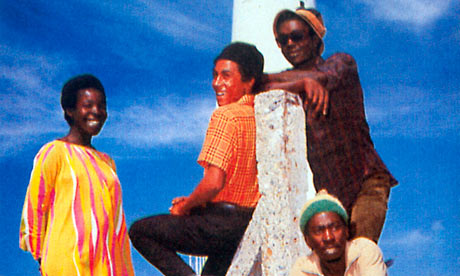
"History lies just beneath the surface of life in Jamaica," observes Colin Grant, and his biography of Bob Marley, Peter Tosh and Bunny Livingston – the founding triumvirate of the Wailers – proves as much an attempt to pin down the island's tangled past and slippery character.
As Jamaica's most famous son, Marley defined his homeland as the isle of reggae and Rastafari, but other identities shimmer in the Caribbean heat: British slave plantation, CIA protectorate, Christian bastion, Ian Fleming's upper-class haven, cocaine trade staging post. That communist Cuba and free-market Florida are near neighbours adds political tension to the mix.
Grant, the biographer of another Jamaican hero, Marcus Garvey, is skilled at peeling away layers of history to reveal, for example, the connection between the bloody labour riots of 1938 and the foundation of Jamaica's two political parties, or the way a dirt-poor itinerant workforce encouraged fatherless families. Peter Tosh's father, a pastor, had nothing to do with his child. Bob Marley's father, a peripatetic white ex-soldier who styled himself "Captain" Marley, likewise abandoned his son.
Given the excellent biographies of Marley already in print, we arguably don't need another, but Grant tells his tale well enough with only the occasional slip (Marley's 1978 Peace Concert was not on "an inky black night" but under a famously full moon), and gives equal weight to the stories of the other two Wailers, assisted by quotations from Roger Steffens's unpublished book on the reclusive Bunny. The only survivor of the trio, Livingston (aka Bunny Wailer), rarely ventures from his farm in St Thomas, and proves an elusive quarry for Grant.
Marley and Livingston had grown up together in the hamlet of Nine Mile, their respective mother and father becoming lovers. Later, their families moved to Trench Town, a 1950s housing project erected amid the squatter camps of west Kingston. Here they met Peter Tosh. Marley later immortalised the district in "No Woman No Cry", where he reminisced about communing in "a government yard in Trench Town", while in "Trench Town Rock" the Wailers cooed beguilingly about "grooving in Kingston 12". In reality, there was little that was beguiling about Trench Town's jumble of shacks, or the stench of the nearby city dump.
Nontheless, Trench Town proved a fertile breeding ground for music, spawning talents like Toots Hibbert, Alton Ellis, Delroy Wilson and the Abyssinians. Many passed under the tutelage of singer Joe Higgs, in whose yard the teenage Wailers first learned the techniques of harmony vocals. Higgs also introduced the trio to producer Coxsone Dodd, for whom they recorded a stream of hits penned mostly by Marley: joyous singalongs like "One Love" and strident sides like "Simmer Down" that appealed to Kingston's lawless "rude boys".
After falling out with the pistol-packing Dodd over royalties, the group spent several years tussling with the piratical Jamaican music business before teaming up with Island Records, a label founded and helmed by an upper-class Jamaican, Chris Blackwell. International acclaim duly followed, with Marley achieving superstar status after the trio split in 1974.
Grant is not much exercised by the tumultuous years of stardom, the attempted assassination of Marley in 1976, or his premature death in 1981. He concentrates on the years spent struggling for recognition, in particular the Wailers' conversion to the burgeoning religion of Rastafari under the influence of another Trench Town luminary, Mortimer Planno. While Biblically grounded, Rasta hailed Ethiopian emperor Haile Selassie as "the living God", and Rastafarian beliefs coloured much of the Wailers' output, as they did most of 1970s reggae. Planno had actually met the reluctant deity on Selassie's 1966 state trip to Jamaica.
Grant's lengthy delineation of Rasta thought (the "I & I" of the title is Rasta speak for "we") shows that its theology can be as dogmatic and schismatic as any papal bull, while its millenarian mood recalls the Revelation-fuelled prophecies of US evangelism. He argues that Rastafarian "sufferers" and the alarmed denizens of uptown Kingston had much in common. For both, "Jamaica was somewhere you put up with. Real life was elsewhere. For Rastas it was Ethiopia, for their upper-crust cousins Zion was Miami."
His contention that the three Wailers offer alternate paths for the black man – "accommodate and succeed (Marley), fight and die (Tosh) or retreat and live (Wailer)" – makes a neat but flawed thesis. Marley was a performer of shamanic power and a prolific songsmith adept at both militant anthems and love songs. Tosh, undeniably charismatic, was one-dimensional by comparison, his greatest hit a Tamla-Motown cover version, his recording contracts suggesting no lack of "accommodation" with the Babylonian music industry. Bunny, appalled by the "freak shows" and "war zones" he encountered on tour in Europe, bowed out to make music, though he occasionally pops up, usually with a tirade against the "slackness" (immorality) of digital reggae and the decline of Jamaica, which now has the third highest murder rate in the world.

